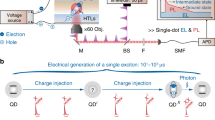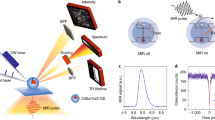Abstract
Semiconductor nanocrystals offer an enormous diversity of potential device applications, based on their size-tunable photoluminescence, high optical stability and 'bottom-up' chemical approaches to self-assembly. However, the promise of such applications can be seriously limited by photoluminescence intermittency in nanocrystal emission, that is, 'blinking', arising from the escape of either one or both of the photoexcited carriers to the nanocrystal surface. In the first scenario, the remaining nanocrystal charge quenches photoluminescence via non-radiative Auger recombination, whereas for the other, the exciton is thought to be intercepted before thermalization and does not contribute to the photoluminescence. This Review summarizes the current understanding of the mechanisms responsible for nanocrystal blinking kinetics as well as core–shell engineering efforts to control such phenomena. In particular, 'softening' of the core–shell confinement potential strongly suppresses non-radiative Auger processes in charged nanocrystals, with successful non-blinking implementations demonstrated in CdSe–CdS core–thick-shell nanocrystals and their modifications.
This is a preview of subscription content, access via your institution
Access options
Subscribe to this journal
Receive 12 print issues and online access
$259.00 per year
only $21.58 per issue
Buy this article
- Purchase on Springer Link
- Instant access to full article PDF
Prices may be subject to local taxes which are calculated during checkout









Similar content being viewed by others
References
Ekimov, A. I., Onushchenko, A. A. & Tzehomski, V. A. Excitonic absorption by CuCl microcrystals in a glass matrices. Sov. Phys. Chem. Glass 6, 511–512 (1980).
Golubkov, V. V., Ekimov, A. I., Onushchenko, A. A. & Tzehomski, V. A. Growth kinetics of the CuCl microcrystals growth in glass matrices. Sov. Phys. Chem. Glass 7, 264–269 (1981).
Ekimov, A. I. & Onushchenko, A. A. Quantum size effect in three dimensional microscopic semiconductor crystals. JETP Lett. 34, 345–349 (1981).
Brus, L. E. A simple model for the ionization potential, electron affinity, and aqueous redox potentials of small semiconductor crystallites. J. Chem. Phys. 79, 5566–5571 (1983).
Brus, L. E. Electron–electron and electron–hole interactions in small semiconductor crystallites: the size dependence of the lowest excited electronic state. J. Chem. Phys. 80, 4403–4409 (1984).
Ekimov, A. I. & Onushchenko, A. A. Size quantization of the electron energy spectrum in semiconductor microcrystals. JETP Lett. 40, 1136–1139 (1984).
Ekimov, A. I., Efros, Al. L. & Onushchenko, A. A. Quantum size effect in semiconductor microcrystals. Solid State Commun. 56, 921–924 (1985).
Efros, Al. L. & Efros, A. L. Interband absorption of light in semiconductor sphere. Sov. Phys. Semicond. 16, 772–775 (1982).
Weidman, M. C., Beck, M. E., Hoffman, R. S., Prins, F. & Tisdale, W. A. Monodisperse, air-stable PbS nanocrystals via precursor stoichiometry control. ACS Nano 8, 6363–6371 (2014).
Murray, C. B., Kagan, C. R. & Bawendi, M. G. Self-organization of CdSe nanocrystallites into three-dimensional quantum dot superlattices. Science 270, 1335–1338 (1995).
Hughes, B. K. et al. Synthesis and spectroscopy of PbSe fused quantum-dot dimers. J. Am. Chem. Soc. 136, 4670–4679 (2014).
Chan, W. C. W. & Nie, S. Quantum dot bioconjugates for ultrasensitive nonisotopic detection. Science 281, 2016–2018 (1998).
Klimov, V. I. et al. Optical gain and stimulated emission in nanocrystal quantum dots. Science 290, 314–317 (2000).
Bruchez, M. J., Moronne, M., Gin, P., Weiss, S. & Alivisatos, A. P. Semiconductor nanocrystals as fluorescent biological labels. Science 281, 2013–2016 (1998).
Kim, T.-H., Jun, S., Cho, K.-S., Choi, B. L. & Jang, E. Bright and stable quantum dots and their applications in full-color displays. MRS Bull. 38, 712–720 (2013).
Lounis, B. & Moerner, W. E. Single photons on demand from a single molecule at room temperature. Nature 407, 491–493 (2000).
Moerner, W. E. Single-photon sources based on single molecules in solids. New J. Phys. 6, 88 (2004).
Nirmal, M. et al. Fluorescence intermittency in single cadmium selenide nanocrystals. Nature 383, 802–804 (1996).
Empedocles, S. A., Norris, D. J. & Bawendi, M. G. Photoluminescence spectroscopy of single CdSe nanocrystallite quantum dots. Phys. Rev. Lett. 77, 3873–3876 (1996).
Bischof, T. S., Correa, R. E., Rosenberg, D., Dauler, E. A. & Bawendi, M. G. Measurement of emission lifetime dynamics and biexciton emission quantum yield of individual InAs colloidal nanocrystals. Nano Lett. 14, 6787–6791 (2014).
Protasenko, V. V., Hull, K. L. & Kuno, M. Disorder-induced optical heterogeneity in single CdSe nanowires. Adv. Mater. 17, 2942–2949 (2005).
Efros, Al. L. & Rosen, M. Random telegraph signal in the photoluminescence intensity of a single quantum dot. Phys. Rev. Lett. 78, 1110–1113 (1997).
Efros, Al. L. Nanocrystals: almost always bright. Nature Mater. 7, 612–613 (2008).
Schmitt-Rink, S., Miller, D. A. B. & Chemla, D. S. Theory of the linear and nonlinear optical properties of semiconductor microcrystallites. Phys. Rev. B 35, 8113–8125 (1987).
Kuno, M., Fromm, D. P., Hamann, H. F., Gallagher, A. & Nesbitt, D. J. Nonexponential 'blinking' kinetics of single CdSe quantum dots: a universal power law behavior. J. Chem. Phys. 112, 3117–3120 (2000).
Chepic, D. I. et al. Auger ionization of semiconductor quantum drops in a glass matrix. J. Lumines. 47, 113–127 (1990).
Kuno, M., Fromm, D. P., Hamann, H. F., Gallagher, A. & Nesbitt, D. J. 'On/off' fluorescence intermittency of single semiconductor quantum dots. J. Chem. Phys. 115, 1028–1040 (2001).
Scher, H. & Montroll, E. W. Anomalous transit-time dispersion in amorphous solids. Phys. Rev. B 12, 2455–2477 (1975).
Shimizu, K. T. et al. Blinking statistics in single semiconductor nanocrystal quantum dots. Phys. Rev. B 63, 205316 (2001).
Zhao, J., Nair, G., Fisher, B. R. & Bawendi, M. G. Challenge to the charging model of semiconductor-nanocrystal fluorescence intermittency from off-state quantum yields and multiexciton blinking. Phys. Rev. Lett. 104, 157403 (2010).
Frantsuzov, P. A. & Marcus, R. A. Explanation of quantum dot blinking without the long-lived trap hypothesis. Phys. Rev. B 72, 155321 (2005).
Tang, J. & Marcus, R. A. Diffusion-controlled electron transfer processes and power-law statistics of fluorescence intermittency of nanoparticles. Phys. Rev. Lett. 95, 107401 (2005).
Mahler, B. et al. Towards non-blinking colloidal quantum dots. Nature Mater. 7, 659–664 (2008).
Chen, Y. et al. 'Giant' multishell CdSe nanocrystal quantum dots with suppressed blinking. J. Am. Chem. Soc. 130, 5026–5027 (2008).
Galland, C. et al. Two types of luminescence blinking revealed by spectroelectrochemistry of single quantum dots. Nature 479, 203–207 (2011).
Javaux, C. et al. Thermal activation of non-radiative Auger recombination in charged colloidal nanocrystals. Nature Nanotech. 8, 206–212 (2013).
Rosen, S., Schwartz, O. & Oron, D. Transient fluorescence of the off state in blinking CdSe/CdS/ZnS semiconductor nanocrystals is not governed by Auger recombination. Phys. Rev. Lett. 104, 157404 (2010).
Frantsuzov, P., Kuno, M., Janko, B. & Marcus, R. A. Universal emission intermittency in quantum dots, nanorods and nanowires. Nature Phys. 4, 519–522 (2008).
Frantsuzov, P. A., Sandor, V.-K. & Boldizsar, J. Model of fluorescence intermittency of single colloidal semiconductor quantum dots using multiple recombination centers. Phys. Rev. Lett. 103, 207402 (2009).
Tang, J. & Marcus, R. A. Mechanisms of fluorescence blinking in semiconductor nanocrystal quantum dots. J. Chem. Phys. 123, 054704 (2005).
Osad'ko, I. S. Model for power-law statistics in blinking photoluminescence of single semiconductor nanocrystals. Chem. Phys. 316, 99–107 (2005).
Osad'ko, I. S. Power-law statistics of intermittent photoluminescence in single semiconductor nanocrystals. JETP Lett. 79, 416–419 (2004).
Krauss, T. D. & Peterson, J. J. Bright future for fluorescence blinking in semiconductor nanocrystals. J. Phys. Chem. Lett. 2010, 1377–1382 (2010).
Pelton, M., Grier, D. G. & Guyot-Sionnest, P. Characterizing quantum-dot blinking using noise power spectra. Appl. Phys. Lett. 85, 819–821 (2004).
Qin, W. & Guyot-Sionnest, P. Evidence for the role of holes in blinking: negative and oxidized CdSe/CdS dots. ACS Nano 6, 9125–9132 (2012).
Jha, P. P. & Guyot-Sionnest, P. Electrochemical switching of the photoluminescence of single quantum dots. J. Phys. Chem. C 114, 21138–21141 (2010).
Qin, W., Liu, H. & Guyot-Sionnest, P. Small bright charged colloidal quantum dots. ACS Nano 8, 283–291 (2014).
Fomenko, V. & Nesbitt, D. J. Solution control of radiative and nonradiative lifetimes: a novel contribution to quantum dot blinking suppression. Nano Lett. 8, 287–293 (2008).
Cragg, G. E. & Efros, Al. L. Suppression of Auger processes in confined structures. Nano Lett. 10, 313–317 (2010).
Kharchenko, V. A. & Rosen, M. Auger relaxation processes in quantum dots and quantum wells. J. Lumines. 70, 158–169 (1996).
Liu, F. et al. Spin dynamics of negatively charged excitons in CdSe/CdS colloidal nanocrystals. Phys. Rev. B 88, 035302 (2013).
Shabaev, A., Rodina, A. V. & Efros, Al. L. Fine structure of the band edge excitons and trions in CdSe/CdS core/shell nanocrystals. Phys. Rev. B 86, 205311 (2012).
Raino, G. et al. Probing the wave function delocalization in CdSe/CdS dot-in-rod nanocrystals by time- and temperature-resolved spectroscopy. ACS Nano 5, 4031–4036 (2011).
Garcia-Santamaria, F. et al. Suppressed Auger recombination in “giant” nanocrystals boosts optical gain performance. Nano Lett. 9, 3482–3488 (2009).
Spinicelli, P. et al. Bright and grey states in CdSe–CdS nanocrystals exhibiting strongly reduced blinking. Phys. Rev. Lett. 102, 136801 (2009).
Vaxenburg, R., Rodina, A. V., Lifshitz, E. & Efros, Al. L. Biexciton Auger recombination in CdSe/CdS core/shell semiconductor nanocrystals. Nano Lett. 16, 2503–2511 (2016).
Park, Y. S., Bae, W. K., Pietryga, J. M. & Klimov, V. I. Auger recombination of biexcitons and negative and positive trions in individual quantum dots. ACS Nano 8, 7288–7296 (2014).
Bae, W. K. et al. Controlled alloying of the core–shell interface in CdSe/CdS quantum dots for suppression of Auger recombination. ACS Nano 7, 3411–3419 (2013).
Park, Y. S., Bae, W. K., Padilha, L. A., Pietryga, J. M. & Klimov, V. I. Effect of the core/shell interface on Auger recombination evaluated by single-quantum-dot spectroscopy. Nano Lett. 14, 396–402 (2014).
Nasilowski, M., Spinicelli, P., Patriarche, G. & Dubertret, B. Gradient CdSe/CdS quantum dots with room temperature biexciton unity quantum yield. Nano Lett. 15, 3953–3958 (2015).
Shimizu, K. T., Woo, W. K., Fisher, B. R., Eisler, H. J. & Bawendi, M. G. Surface-enhanced emission from single semiconductor nanocrystals. Phys. Rev. Lett. 89, 117401 (2002).
Chen, O. et al. Compact high-quality CdSe–CdS core–shell nanocrystals with narrow emission linewidths and suppressed blinking. Nature Mater. 12, 445–451 (2013).
Qin, H. et al. Single-dot spectroscopy of zinc-blende CdSe/CdS core/shell nanocrystals: nonblinking and correlation with ensemble measurements. J. Am. Chem. Soc. 136, 179–187 (2014).
Pelton, M., Smith, G., Scherer, N. F. & Marcus, R. A. Evidence for a diffusion-controlled mechanism for fluorescence blinking of colloidal quantum dots. Proc. Natl Acad. Sci. USA 104, 14249–14254 (2007).
Acknowledgements
The authors thank C. Kagan, K. Kuno and R. Vaxenburg for help with figure preparation. Al.L.E. acknowledges the financial support of the Office of Naval Research (ONR) through the Naval Research Laboratory Basic Research Program. D.J.N. acknowledges support for this work from the National Science Foundation (CHE1266416, PHYS1125844), with additional support from the Department of Energy, Office of Basic Energy Sciences (DE-FG02-09ER16021).
Author information
Authors and Affiliations
Corresponding author
Ethics declarations
Competing interests
The authors declare no competing financial interests.
Rights and permissions
About this article
Cite this article
Efros, A., Nesbitt, D. Origin and control of blinking in quantum dots. Nature Nanotech 11, 661–671 (2016). https://doi.org/10.1038/nnano.2016.140
Received:
Accepted:
Published:
Issue Date:
DOI: https://doi.org/10.1038/nnano.2016.140
This article is cited by
-
Recent Advances in Patterning Strategies for Full-Color Perovskite Light-Emitting Diodes
Nano-Micro Letters (2024)
-
Radiative suppression of exciton–exciton annihilation in a two-dimensional semiconductor
Light: Science & Applications (2023)
-
Defocused imaging-based quantification of plasmon-induced distortion of single emitter emission
Light: Science & Applications (2023)
-
Electric-field-induced colour switching in colloidal quantum dot molecules at room temperature
Nature Materials (2023)
-
Unveiling non-radiative center control in CsPbBr3 nanocrystals: A comprehensive comparative analysis of hot injection and ligand-assisted reprecipitation approaches
Nano Research (2023)



